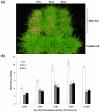Expression of a novel antimicrobial peptide Penaeidin4-1 in creeping bentgrass (Agrostis stolonifera L.) enhances plant fungal disease resistance
- PMID: 21931807
- PMCID: PMC3171467
- DOI: 10.1371/journal.pone.0024677
Expression of a novel antimicrobial peptide Penaeidin4-1 in creeping bentgrass (Agrostis stolonifera L.) enhances plant fungal disease resistance
Abstract
Background: Turfgrass species are agriculturally and economically important perennial crops. Turfgrass species are highly susceptible to a wide range of fungal pathogens. Dollar spot and brown patch, two important diseases caused by fungal pathogens Sclerotinia homoecarpa and Rhizoctonia solani, respectively, are among the most severe turfgrass diseases. Currently, turf fungal disease control mainly relies on fungicide treatments, which raises many concerns for human health and the environment. Antimicrobial peptides found in various organisms play an important role in innate immune response.
Methodology/principal findings: The antimicrobial peptide - Penaeidin4-1 (Pen4-1) from the shrimp, Litopenaeus setiferus has been reported to possess in vitro antifungal and antibacterial activities against various economically important fungal and bacterial pathogens. In this study, we have studied the feasibility of using this novel peptide for engineering enhanced disease resistance into creeping bentgrass plants (Agrostis stolonifera L., cv. Penn A-4). Two DNA constructs were prepared containing either the coding sequence of a single peptide, Pen4-1 or the DNA sequence coding for the transit signal peptide of the secreted tobacco AP24 protein translationally fused to the Pen4-1 coding sequence. A maize ubiquitin promoter was used in both constructs to drive gene expression. Transgenic turfgrass plants containing different DNA constructs were generated by Agrobacterium-mediated transformation and analyzed for transgene insertion and expression. In replicated in vitro and in vivo experiments under controlled environments, transgenic plants exhibited significantly enhanced resistance to dollar spot and brown patch, the two major fungal diseases in turfgrass. The targeting of Pen4-1 to endoplasmic reticulum by the transit peptide of AP24 protein did not significantly impact disease resistance in transgenic plants.
Conclusion/significance: Our results demonstrate the effectiveness of Pen4-1 in a perennial species against fungal pathogens and suggest a potential strategy for engineering broad-spectrum fungal disease resistance in crop species.
Conflict of interest statement
Figures







Similar articles
-
Transcript Profiling and Gene Identification Involved in the Ethylene Signal Transduction Pathways of Creeping Bentgrass (Agrostis stolonifera) during ISR Response Induced by Butanediol.Molecules. 2018 Mar 20;23(3):706. doi: 10.3390/molecules23030706. Molecules. 2018. PMID: 29558428 Free PMC article.
-
RNA-Seq analysis of the Sclerotinia homoeocarpa--creeping bentgrass pathosystem.PLoS One. 2012;7(8):e41150. doi: 10.1371/journal.pone.0041150. Epub 2012 Aug 8. PLoS One. 2012. PMID: 22905098 Free PMC article.
-
Brachypodium: A Potential Model Host for Fungal Pathogens of Turfgrasses.Phytopathology. 2017 Jun;107(6):749-757. doi: 10.1094/PHYTO-08-16-0318-R. Epub 2017 Apr 12. Phytopathology. 2017. PMID: 28134592
-
Recent developments in metabolomics-based research in understanding transgenic grass metabolism.Metabolomics. 2019 Mar 15;15(4):47. doi: 10.1007/s11306-019-1507-4. Metabolomics. 2019. PMID: 30877485 Review.
-
Breeding for disease resistance in the major cool-season turfgrasses.Annu Rev Phytopathol. 2006;44:213-34. doi: 10.1146/annurev.phyto.44.070505.143338. Annu Rev Phytopathol. 2006. PMID: 17061916 Review.
Cited by
-
Advances in Agrobacterium tumefaciens-mediated genetic transformation of graminaceous crops.Protoplasma. 2016 May;253(3):691-707. doi: 10.1007/s00709-015-0905-3. Epub 2015 Dec 10. Protoplasma. 2016. PMID: 26660352 Review.
-
Heterologous Production of Antimicrobial Peptides: Notes to Consider.Protein J. 2024 Apr;43(2):129-158. doi: 10.1007/s10930-023-10174-w. Epub 2024 Jan 5. Protein J. 2024. PMID: 38180586
-
Label-free nanoUPLC-MSE based quantification of antimicrobial peptides from the leaf apoplast of Nicotiana attenuata.BMC Plant Biol. 2015 Jan 21;15:18. doi: 10.1186/s12870-014-0398-9. BMC Plant Biol. 2015. PMID: 25604123 Free PMC article.
-
De-novo design of antimicrobial peptides for plant protection.PLoS One. 2013 Aug 12;8(8):e71687. doi: 10.1371/journal.pone.0071687. eCollection 2013. PLoS One. 2013. PMID: 23951222 Free PMC article.
-
Is genetic engineering ever going to take off in forage, turf and bioenergy crop breeding?Ann Bot. 2012 Nov;110(6):1317-25. doi: 10.1093/aob/mcs027. Epub 2012 Feb 28. Ann Bot. 2012. PMID: 22378838 Free PMC article. Review.
References
-
- Haydu J, Hodges A, Hall C. Economic impacts of the turfgrass and lawn care industry in the United States. University of Florida IFAS Extension website. 2006;23 Available: http://edis.ifas.ufl.edu/fe632. Accessed 2011 August.
-
- The national turfgrass research initiative. National Turfgrass Evaluation Program website. 2003;23 Available: http://www.ntep.org/pdf/turfinitiative.pdf. Accessed 2011 August.
-
- Chai B, Maqbool SB, Hajela RK, Green D, Vargas JM, et al. Cloning of a chitinase-like cDNA (hs2), its transfer to creeping bentgrass (Agrostis palustris Huds.) and development of brown patch (Rhizoctonia solani) disease resistant transgenic lines. Plant Sci. 2002;163:183–193.
-
- Guo Z, Bonos S, Meyer WA, Day PR, Belanger FC. Transgenic creeping bentgrass with delayed dollar spot symptoms. Mol Breed. 2003;11:95–101.
-
- Keymanesh K, Soltani S, Sardari S. Application of antimicrobial peptides in agriculture and food industry. World J Microbiol Biotechnol. 2009;25:933–944.
Publication types
MeSH terms
Substances
LinkOut - more resources
Full Text Sources

